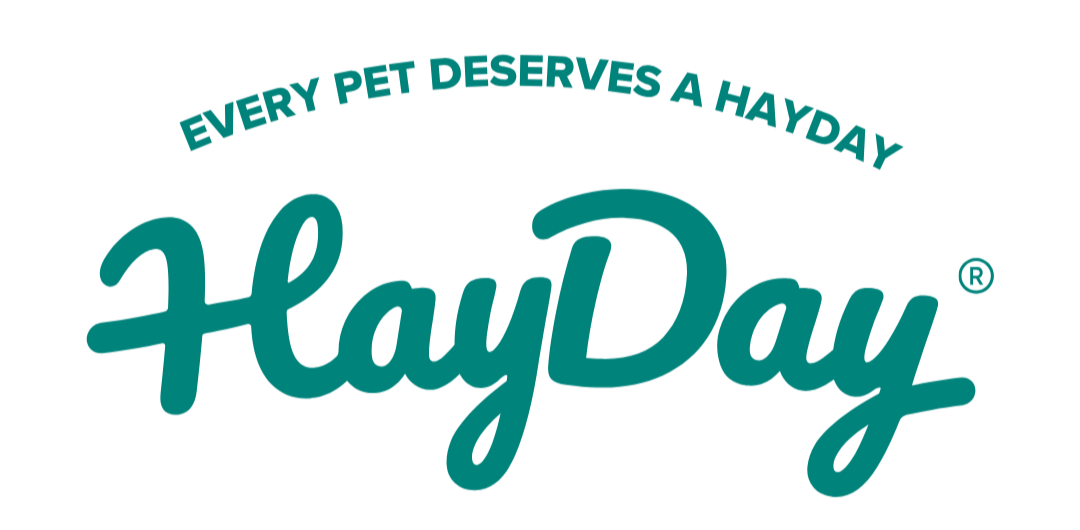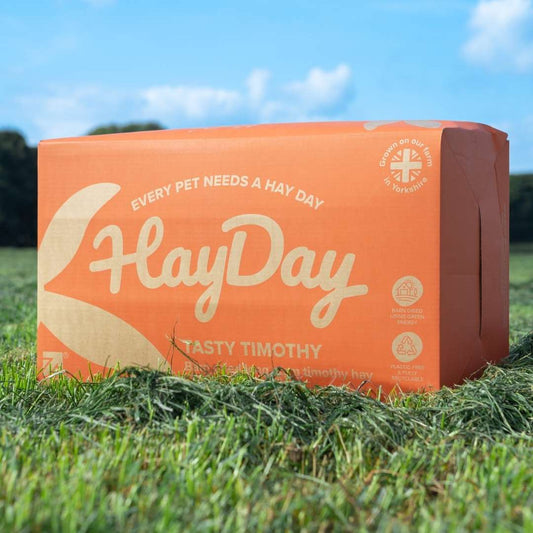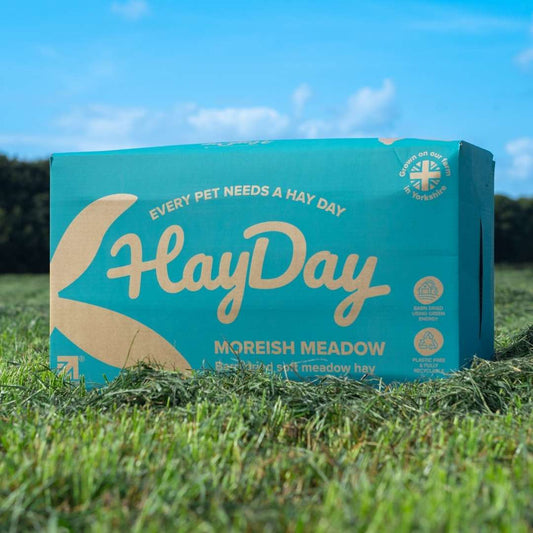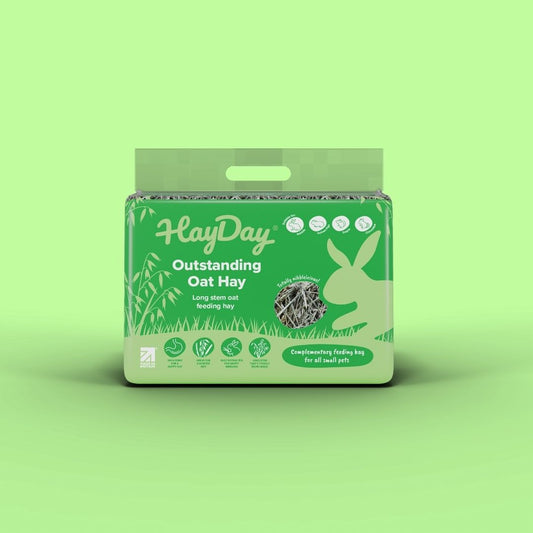If you’re wondering “can rabbits eat lettuce?”, the answer is yes.
While dark leafy varieties like romaine are healthy options, others, especially iceberg lettuce, can cause diarrhoea when fed in excess.
Each and every rabbit owner should be aware that a rabbit's diet should consist mainly of high-quality premium hay such as our Tasty Timothy Hay; where adding nutritious treats such as a handful of leafy greens is a great idea too.
Here at HayDay we have taken the time to help you discover the best ways to feed lettuce to your bunny, understand the risks, and learn about how to diversify their diet.
Feeding Rabbits Lettuce - Overview
-
The best lettuce varieties for rabbits are romaine, red leaf lettuce, and butterhead, which are high in fibre and nutrients, while iceberg lettuce offers a much lower nutritional value treat.
-
It's good to remember that every rabbit is unique, but as a guide rabbits should be fed approximately a handful of leafy greens each day as part of a balanced diet, ensuring no more than 5-10% of their daily intake is fresh vegetables.
-
Introducing lettuce and other vegetables into a rabbit’s diet should be done gradually and with close observation to monitor their digestion and overall health, while maintaining a core diet of high-quality hay, the appropriate amounts of pellets, leafy greens and water.
Choosing Safe Types Of Lettuce For Rabbits
When it comes to a rabbit’s diet, not all lettuces are created equal. The diversity within the lettuce family means that some varieties are better suited to your rabbit than others.
In fact, rabbits tend to prefer lettuce that has leafy greens with darker leaves like romaine, red leaf lettuce, and butterhead lettuces, as they stand out as nutritional champions for your furry friends. These greens, packed with fibre and vital nutrients, are not only safe for rabbits but also provide a healthful boost to their daily diet.
Romaine and Leaf Lettuces: The Safer Choices
Among the leafy greens, romaine lettuce emerges as a top contender for your rabbit’s health.
Both red-leaf and green-leaf lettuces share the spotlight, being the safer choices due to their higher fibre and nutrient content. These dark, leafy greens not only support your bunny’s digestion but also contribute to an overall balanced diet.
Incorporating these fresh greens into your rabbit’s daily meals guarantees a beneficial, nutritious and varied diet for your rabbits.
Iceberg Lettuce: Low Nutritional Value and Risks
When it comes to Iceberg Lettuce, this type of lettuce is infamous for its very high water content and low nutritional value, which translates to very little benefit for your rabbit’s health.
Moreover, iceberg lettuce contains lactucarium, which can pose harmful effects if ingested in large quantities.
With these considerations in mind, it’s advisable to keep iceberg lettuce out of your rabbit’s dietary plan.
Other Lettuces and Greens to Consider
Venturing beyond the realm of lettuce, there’s a whole array of leafy greens that can adorn your bunny’s plate. Some options include:
These healthy veggies can bring variety and additional nutrients to your rabbit’s diet. However, always remember the golden rule: moderation is key to maintaining the dietary balance that keeps your rabbit hopping with health.
How Much Lettuce Can Rabbits Eat?
When it comes to portion size, the question arises, “How much lettuce can rabbits consume?”
While every rabbit is different and we would always recommend consulting your vet, we recommend feeding a handful of leafy greens to your furry friend.
Feeding leafy greens is the opposite to feeding Meadow Hay or Timothy Hay as they need unlimited access to premium quality hay at all times. It's important to bear in mind that when feeding lettuce every day, as well as any other fresh vegetables, should comprise no more than 10% of their daily food intake.
Mixing It Up: Variety in the Diet
By mixing very small amounts of 3 to 5 different types of greens and vegetables every day, your rabbit will receive a more balanced array of nutrients.
Different vegetables like bell peppers, carrot tops, and bok choy add new flavours and textures, keeping mealtime interesting and nutritionally sound - which in turn will encourage your rabbit to eat more!
Health Benefits of Lettuce for Rabbits
Selected wisely, lettuce can be more than a delicious snack; it can provide hydration and fibre to your rabbit’s diet.
Dark leafy greens like romaine lettuce are packed with vitamins, minerals, and antioxidants, which are instrumental in your rabbit’s overall health.
These nutrient-rich greens not only contribute to maintaining healthy hydration levels but also support digestive health, ensuring your bunny is as bouncy on the inside as they are on the outside.
Hydration Through Greens
Hydration is a key benefit of incorporating leafy greens into your rabbit’s diet. Lettuce varieties with high water content, such as romaine and green leaf lettuce, offer a refreshing way for your rabbit to stay hydrated.
The water in these greens supplements, alongside their daily drinking water, is particularly beneficial during the warmer months or for those bunnies that are less inclined to sip from their water bottles frequently.
Fibre for Digestive Health
Along with key fibre which is found in Timothy Hay, the fibre content in lettuce plays a key role in promoting a rabbit’s digestive health. Dark leafy greens are rich in soluble fibre, which is crucial for maintaining a smooth-operating digestive system.
The fibrous content in vegetables like romaine lettuce helps to prevent blockages and supports regular gut movement, which is vital for rabbits, whose health hinges on their digestive system’s efficiency.
Adding fibrous foods to your rabbit’s diet is an effective way to ward off digestive problems and keep your furry friend healthy.
Potential Concerns When Feeding Lettuce
Offering lettuce to your rabbit comes with certain considerations. The type of lettuce and its preparation need thoughtful attention to prevent potential adverse effects.
Pesticides and Chemicals
We cannot overstate the importance of washing lettuce and other fresh veggies thoroughly before offering it to your rabbit. Harmful chemical residues on unwashed lettuce can pose significant risks to your bunny’s health.
Signs of Digestive Issues
As you introduce lettuce into your rabbit’s diet, it’s vital to watch out for any indications of digestive problems.
A deviation from the norm in your rabbit’s stool pattern, such as soft faeces or signs of gastrointestinal discomfort, could indicate a negative reaction to the latest addition in their diet.
Monitoring your rabbit closely after introducing greens will help you detect any early signs of digestive upset and take appropriate action to ensure their continued well-being.
Introducing Lettuce into a Rabbit's Diet
The introduction of lettuce into a rabbit’s diet should be a gentle and measured process. As we have stated every rabbit is different, therefore, starting with a small quantity is advised to prevent any potential digestive tract issues.
This gradual approach, introducing new foods to your rabbit over a period of 7 to 14 days, allows you to monitor how your rabbit reacts to the new food and allows you to make adjustments accordingly.
Alternatives to Lettuce in a Rabbit's Diet
Though lettuce can be a beneficial part of a rabbit’s diet, it isn’t the sole option. Exploring alternatives can provide your bunny with the variety and nutritional balance they need.
There’s an abundance of vegetables out there that can serve as wonderful supplements or substitutes for lettuce, ensuring your rabbit’s meals are not only delicious but also nutritionally complete.
Safe and Nutritious Vegetable Options
There is a smorgasbord of safe and nutritious vegetable options for rabbits beyond lettuce. Some examples include:
-
Bell peppers
-
Broccoli
-
Carrot tops leaves
-
Cucumbers
These vegetables offer diverse nutrients and textures for your rabbit’s diet.
Celery stalks, for instance, are not only crunchy and satisfying but also provide essential vitamins and minerals.
These alternatives to lettuce can add to the richness of your rabbit’s diet, contributing positively to their health and happiness.
Herbs as Flavorful Additions
Herbs can also play a flavorful role in spicing up your rabbit’s diet. Some herbs that you can introduce to your bunny’s meals include:
-
Basil
-
Dill
-
Mint
-
Parsley
These herbs not only offer a burst of flavour but are also packed with essential vitamins and minerals.
Balancing Your Rabbit's Meals
Hay, rabbit pellets, fresh veggies and water all play distinct roles in providing your rabbit with a complete and healthy diet. By understanding these components, you can ensure your rabbit enjoys a diverse, nutritious menu that supports their well-being.
Main Course: High Quality Hay
The base toa healthy rabbit diet is feeding high-quality hay (approximately 80 to 90% of their diet) such as Timothy Hay or Meadow Hay.
This staple is crucial not just for their digestive health but also for maintaining dental health, as the chewing action helps wear down their ever-growing teeth.
Providing a constant supply of high-quality, sweet-smelling, dust-free hay ensures your rabbit gets the fibre they need to thrive. Other healthy hay types are:
-
Oat Hay
Hay is a critical component of a rabbit's diet that must not be ignored. If you're unsure of which hay to feed, why not try one of our 50/50 boxes to see the benefits and differences.
Summary
In conclusion, the best choices for your bunny’s health are darker, leafy greens like romaine, which offer both hydration and fibre.
Introducing lettuce should be a gradual process (over 7 to 14 days), with careful observation to avoid digestive issues. Remember to wash all greens thoroughly to rid them of pesticides and chemicals.
By including a variety of vegetables and occasional herbs, you can create a balanced and nutritious diet that will keep your rabbit happy and healthy.
Relevant Advice
Frequently Asked Questions
Is it safe for rabbits to eat romaine lettuce every day?
Yes, it is safe for rabbits to eat romaine lettuce every day as long as it's given in the appropriate portion, well-washed, and free from pesticides. Be sure to monitor your rabbit for any changes in behaviour or digestion.
How do I introduce new vegetables like lettuce to my rabbit's diet?
Introduce lettuce to your rabbit's diet gradually by starting with a small piece and closely monitoring their reaction over a 24-hour period to ensure there are no digestive issues. You should keep gradually introducing more to their diet over a period of 7 to 14 days.
What are some lettuce alternatives I can feed my rabbit?
You can consider feeding your rabbit vegetables like bell peppers, cucumbers, broccoli, celery and cabbage as alternatives to lettuce, along with herbs like parsley and mint in moderation. It's important to provide a balanced and varied diet for your rabbit.





